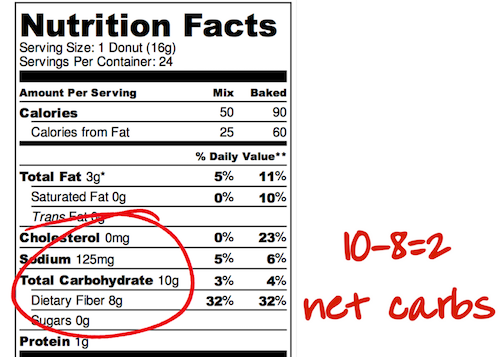Let’s talk about carbs, baby! We know that not all carbs are created equal. We’ve got simple/refined carbs, we’ve got complex carbs, and … we have net carbs.
You may have heard them called “digestible carbs.” This refers to a portion of the carbs you consume that is actually absorbed by your body.
Simple carbs contain a single sugar unit, or at most two sugar units, and are found in foods like fruit, milk, sugar, and honey. Complex carbs contain several sugar units linked together and are found in grains and starchy vegetables like sweet potatoes.
When you eat a food that contains carbohydrates, most of the carbs are broken down into single sugar units. The small intestine does this because only single sugar units can be absorbed easily by the body for fuel. Of note, this is part of the reason why simple carbs spike your blood sugar so quickly!
However, some carbs can't be broken down into individual sugar units, leading them to be only partially absorbed. This process includes carb sources which contain fiber. This is why complex carbs, (and eating fiber alongside your carbs), slow the absorption of sugar into the bloodstream – it takes the body longer to break the sugar down.
Because of this, if you subtract the fiber content from the overall carbohydrate content, you can find the amount of carbohydrates that will actually be absorbed by the body.
There are two main kinds of fiber; soluble and insoluble. Soluble fiber dissolves in water while insoluble fiber doesn’t.
Soluble fiber forms a gel-like substance when it is dissolved in water. It reduces blood cholesterol and controls glucose levels. Soluble fiber can be found in oats, peas, beans, apples, citrus fruits, carrots, barley and psyillium.
Insoluble fiber helps move material through your digestive track. This makes it great for relieving constipation. To get more insoluble fiber, increase your intake of whole grains, nuts, beans and vegetables like cauliflower, green beans and potatoes.
Whole foods like vegetables and fruits contain natural fiber. This means you can simply subtract the amount of fiber from the amount of total carbohydrates and find the net carbs. Since whole, fresh foods don’t usually come with nutritional labels, you can use resources like the USDA Food Composition Database to find nutrition information on nearly any food.
What about packaged foods? They have handy nutritional labels! Just look at the label and perform your subtraction from there.
Look closely at foods advertised as “low in net carbs.” Some are accurately represented, but be sure to check nutrition labels carefully. These products can contain more preservatives, unhealthy trans fats, even more sugar (believe it or not) than traditional products.
Many people can benefit from counting net carbs, especially if you're on a low-carb or keto diet. Such diets usually allow 20-50 net carbs a day. They generally manage blood sugar levels well and can also result in losing excess body fat. But you should always test your blood sugar and NEVER change your diet, medication dosage or frequency without consulting your physician.
An advantage of counting net carbs is that it may increase the number of foods you are “allowed” to have. However, don’t let the fact that a food is low in net carbs be your invitation to eat as much of it as you like.
The Glycemic Index can be helpful in learning how foods may interact with your body and blood sugar. A diet balanced with protein, healthy fats, and fiber must still reign supreme for overall health and lower blood sugar.
Sources: https://www.healthline.com/nutrition/net-carbs#section6


My sister says that sugar when listed is not counted in the carb count and therefore I shouldn’t.eat. I try telling her that I it is included in carb count. I realize that too much sugar is not good for me and that the higher the carb count is that there is more sugar. Is she right or me.
You are correct Nancy! Sugar must be included in the total carb count!
Lots of good information just need to get more recipes to help with my diabetics
I went on a website that touted their product as low carb. One of the items listed as 2 net carbs. It had a total carb count of 18 with a fiber count of 8. I emailed them to ask how they got the 2 net carbs listed when what I learned showed that it should be 10.
Their answer was that I must take away the sugar alcohol and this gives the 2 net carbs. There was no sugar alcohol grams listed. Only sugar. Who is right and how do I really figure out what the real net carbs are.
Technically, it’s correct that you should subtract sugar alcohols as well as fiber. We don’t use sugar alcohols in our products because some customers report gastric disturbances and some scientists believe they’re not healthy for our gut. They should appear on the nutritional label as sugar alcohols along with the number of grams. If they don’t, then I would only subtract the fiber grams.
I just want to know if the sandwich pictured is diabetic friendly. It looks healthy and delicious and like something I would like to try
Since it was a stock photo I am not sure about the bread. All the insides are diabetic friendly from what I can tell. You could make this Oopsie Roll ( https://diabetickitchen.com/oopsie-roll/ ) and use it for a sandwich. Also we have had people tell us they have used our Diabetic Kitchen Cheesey Bread Muffin Mix as bread for sliders! If I hear of someone who has a great sandwich bread for you I will post and send you the link.
My doctor says that if you read the Ingredients in the back and it’s a sugar alcohol,Sugar is sugar
My husband is diabetic and we both of trying to lose some pounds. We are attempting to follow the Keto plan with protein, very little sugar and watch all carbs.
Will eating just strawberries&blueberries for breakfast raise your sugar